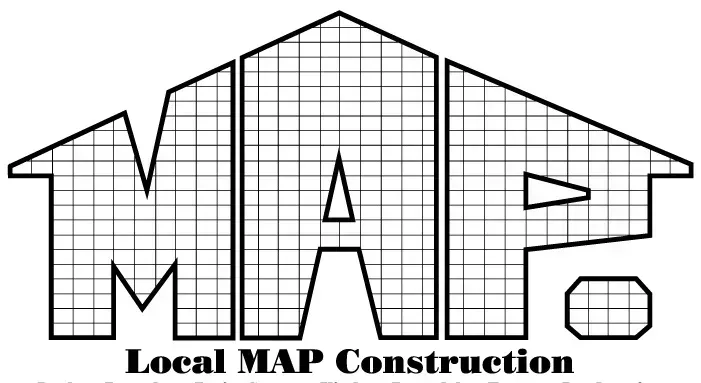Basement Finishing Guide: Tips, Costs, and More
If you’re a homeowner looking to maximize your living space, finishing your basement is a great way to add value and create an entirely new area to spend time in. A finished basement can be used for anything from a home theater to a game room to an extra bedroom. However, the
basement finishing process can seem overwhelming, especially if you need help figuring out where to start or what to expect. That’s why we’ve put together this ultimate guide to basement finishing, complete with tips, tricks, and cost-effective ideas to help you create the finished basement of your dreams. This guide covers everything from assessing your unfinished basement to designing your new living space. So, whether you’re looking for finished basement ideas or want to learn more about the basement finishing process, this blog is for you. Let’s get started!
What is Basement Finishing?
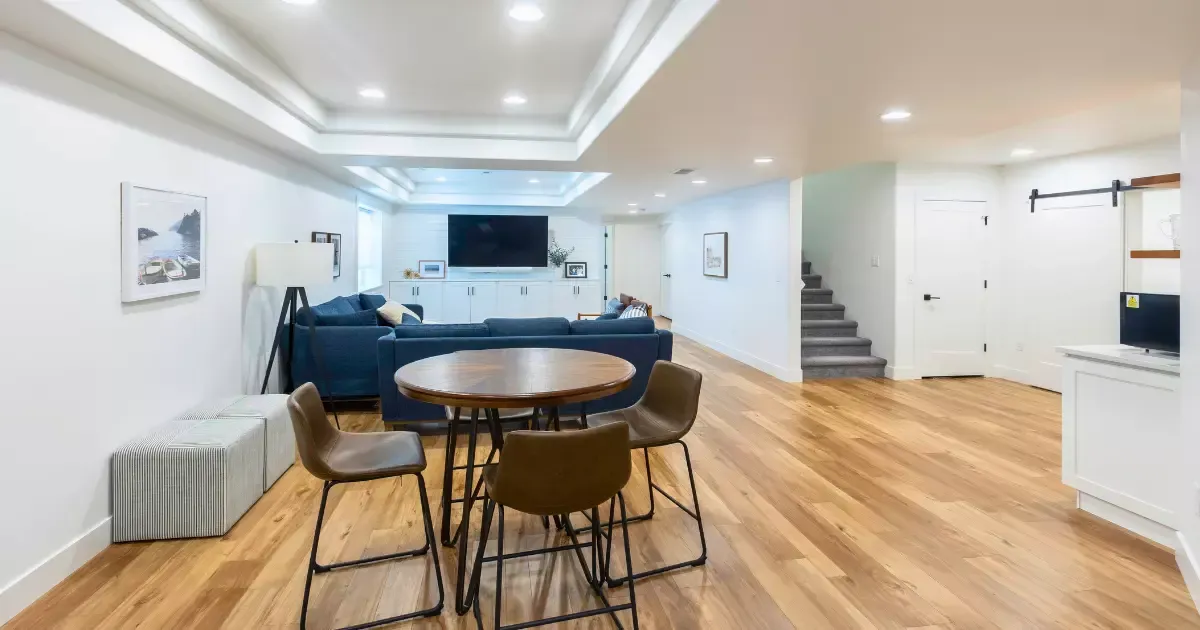
Basement finishing is transforming an unfinished basement into a livable and functional space. This can involve adding walls, flooring, lighting, and other features like home theaters or home offices. It not only enhances your home's value but also provides additional living space for your family to enjoy. Whether you're looking to create a cozy retreat or a functional workspace, basement finishing offers endless possibilities to maximize your home's potential.
What are the Benefits of A Finished Basement?
A finished basement can provide added space for new rooms, which many homeowners find useful for various purposes. Whether you need a home gym, extra bedrooms, or a playroom for the kids, a finished basement can give you the space you need without sacrificing quality. Additionally, a finished basement can increase your home's value, making it a smart investment. The versatility of this space allows for endless customization to suit your family's needs and lifestyle.
What are the Advantages and Disadvantages of Basement Finishing?
There are several advantages to finishing a basement, including increased living space and adding value to your house. Additionally, a finished basement can enhance the overall aesthetic appeal and functionality of your home. However, there are also potential disadvantages, such as the cost and potential moisture issues that may arise. It’s essential to weigh these factors carefully before starting a basement project. Consulting with professionals and conducting thorough research can help you make an informed decision and avoid common pitfalls.
What are the Differences Between A Finished And Unfinished Basement?
Unfinished basements are typically cold and dark spaces unsuitable for living. By contrast, a finished basement can be a comfy place where family and friends can gather and relax, significantly enhancing your home’s livability. It can also increase the overall value of your home, making it a smart investment.
Finishing a basement can be a significant undertaking, but it can be an excellent investment in your home. Creating a functional and attractive living space can add value and enjoyment to your home without sacrificing quality. Before starting a basement project, it’s essential to assess your unfinished basement, plan your project carefully, and consider the costs involved. Thorough planning and budgeting will ensure a smooth project and a finished basement that meets your needs and expectations.
How to Plan Your Basement Finishing Project
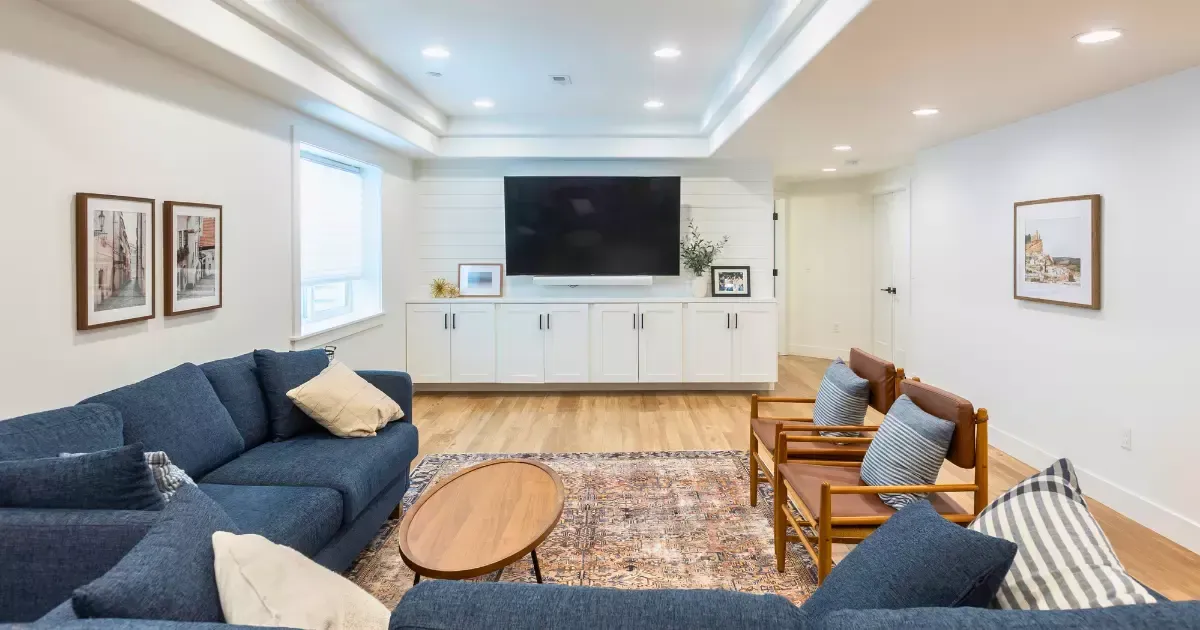
The first step in planning a basement finishing project is identifying your needs and wants. Ask yourself questions such as:
- How do I plan to use the space?
- What features do I want to include in the finished basement?
- How much storage do I need?
- What design elements are essential to me?
By answering these questions, you can create a detailed plan for your basement remodel that aligns with your goals and needs.
Determine The Budget
The cost of a basement remodeling project can vary widely, depending on factors such as energy, material, and labor costs. To determine your budget, consider the following:
- What are the affordable prices on the project?
- How much will the project increase your home value?
- What are financing options available to you?
By determining your budget up front, you can make informed decisions about the scope and design of your home improvement project.
Choose The Right Contractor
When it comes to finishing a basement, working with professional local basement contractor can be critical to the success of your project. Look for contractors with experience in basement remodels and finished basements, and ask for references from past clients. A project manager can also help coordinate the work of various subcontractors and ensure that your project stays on track. Check out also our article on how to find a local basement finisher to learn more tips.
Obtain Permits and Approvals
Before starting any basement remodeling project, obtaining the necessary permits and approvals from local building codes is vital. These may include permit fees, inspections, and compliance with local zoning laws. Failing to obtain the necessary permits can result in fines and legal complications. Most of the time, when you choose a local basement contractor, they will help you with getting permits.
Proper planning is key to a successful basement finishing project. By following these tips, homeowners can make informed decisions about their basement finishing projects, including identifying their needs and wants, determining the budget, choosing the right contractor, and obtaining necessary permits and approvals. A well-planned and executed basement remodel can add value to your home and create a functional and attractive habitable space.
How Much Does Basement Finishing Project Cost?
Basement finishing is a great way to add livable space to your home and increase its value. However, it can be a significant investment, so it’s essential to understand the factors that affect the cost of basement finishing.
The average cost of finishing a basement is between $25 and $50 per square foot. For an average-sized basement of around 1,000 square feet, the cost can range from $25,000 to $50,000. However, the overall cost can be higher or lower depending on the abovementioned factors.
What are the Factors Affect the Basement Finishing Cost?
The cost of basement finishing can vary significantly depending on several factors. Some of the critical factors that can affect the overall cost of your basement finishing project include the following:
- Square Footage. The larger the basement area, the more expensive it will be to finish it. You may ask the help of the basement finishing contractor to help you determine the right square footage.
- Materials. The materials you choose for your newly finished basement will significantly impact the overall cost. High-quality materials will drive up the price, but they may also improve the value of your home.
- Remodeling Services. Hiring professional basement finishing contractor can also increase basement finishing costs. The more experienced and qualified the contractor is, the more expensive their services may be.
- Energy Costs. Adding electrical, heating, and cooling systems to the basement can drive up energy costs in the long run. Additionally, incorporating energy-efficient systems can be an upfront investment that saves money over time.
- Linear Foot. The cost of finishing your basement will depend on the linear foot measurement of the walls, including the framing, insulation, and drywall.
- Habitable Space. To create a habitable space, the basement needs proper egress windows and emergency exits to comply with building codes. This can add to the overall cost of the project. Moreover, ensuring proper ventilation and moisture control is essential to maintain a comfortable living environment.
How Do I Save Money on Basement Finishing?
There are several ways to cut costs when finishing a basement without sacrificing quality. Some homeowners decide to handle some tasks themselves, such as painting or installing fixtures. They can also choose more affordable materials or look for discounts and deals on construction materials. Utilizing DIY methods for simpler tasks can significantly reduce labor costs, while still achieving a polished look.
Finishing a basement is a significant investment, but it can significantly increase your home value and provide additional living space. Homeowners can finish basements at affordable prices by understanding the factors that affect the overall cost and implementing cost-saving strategies.
How to Design Your Finished Basement?
Designing your finished basement is an exciting part of the basement finishing project. It’s a chance to create a space that suits your needs and preferences. Here are some essential factors to consider when designing your finished basement.
Decide on Your Floor Plan and Layout
Before starting your basement finishing project, you need a clear idea of how you want to use the space. This will guide the floor plan and layout design. For example, you might want to create a home theater, a guest bedroom, or a playroom for kids. Ensure that the layout maximizes the available space while considering factors such as ceiling height, foundation walls, floor joists, and existing plumbing.
Plan Your Lighting and Electrical
Proper lighting and electrical planning are crucial for creating a functional and comfortable space in your finished basement. Consider adding recessed lighting, pendant lighting, or floor lamps to create a cozy ambiance. Also, plan for electrical outlets and switches in appropriate locations for convenience.
Choose the Right Flooring
Choosing the right flooring is essential for your newly finished basement’s aesthetic appeal and durability. Popular flooring options include hardwood, laminate, vinyl, and carpet. Ensure the flooring suits a basement’s size, moisture levels, and traffic. Opt for moisture-resistant flooring to prevent damage and maintain longevity.
Have Finishing Basement Walls and Ceilings
Finishing your basement walls and ceilings can transform the look of your space. You can add drywall, paneling, or paint to finish the walls. Consider installing a drop ceiling for easy access to plumbing pipes and ductwork. You can also consider using a soundproofing material to minimize noise transfer from the basement.
Add Windows and Doors
Windows and doors can enhance your newly finished basement’s natural light and ventilation. Consider adding an egress window for safety and to allow natural light into the basement. Ensure that the doors you choose suit the basement’s purpose, such as a wet bar, storage room, or bathroom.
Designing your finished basement is crucial to your basement finishing project. Take your time planning the floor plan, lighting, flooring, walls, ceiling finishes, and windows and doors. This will ensure you create a functional, comfortable, and visually appealing space that meets your needs and preferences.
How to Add Functionality to Your Basement?
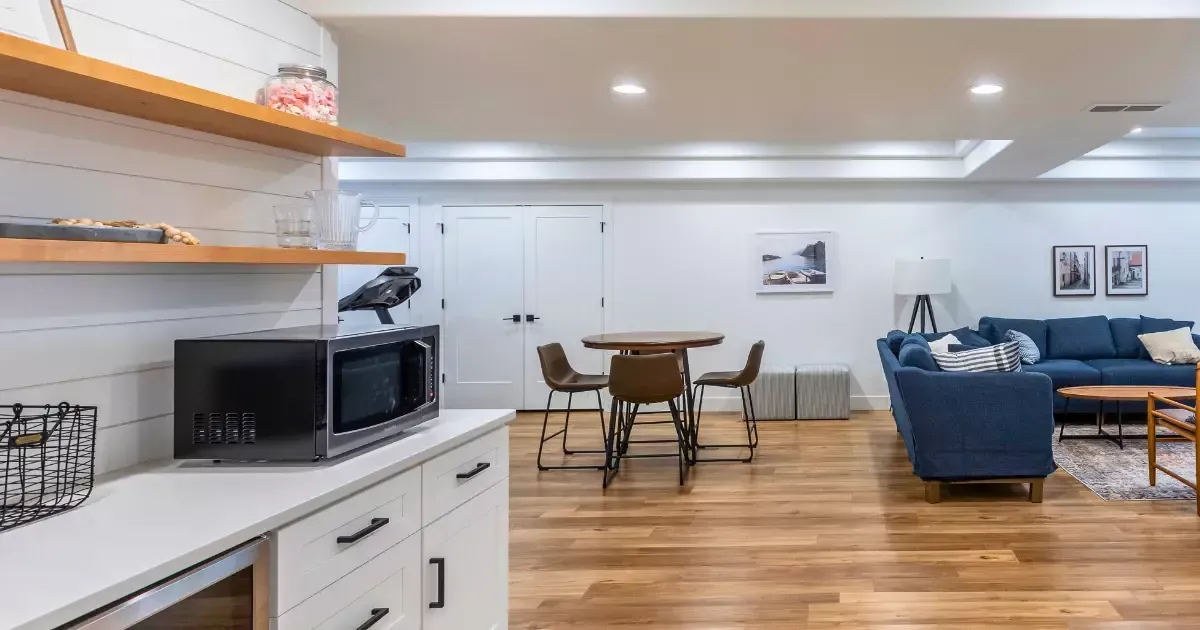
Congratulations, you’ve made it this far in our ultimate guide to basement finishing! Now that you have a solid understanding of the planning and construction phases, it’s time to consider how to make your newly finished basement space functional for your household’s needs. Here are some popular ideas to consider:
Create A Home Theater
Creating a home theater is one of the most popular uses for a finished basement. Before you get started, it’s essential to consider the size of the room and any load-bearing walls that may limit your options. You may also need to install soundproofing materials to prevent sound from traveling to other parts of the house. You can expect to spend around $1,000 to $5,000 on mid-grade materials, a projector, a screen, and a surround sound system.
Build A Home Office
With more and more people working from home, a dedicated home office is becoming increasingly important. Consider adding extra outlets, lighting, and built-in storage to maximize the space. In terms of costs, you can expect to spend around $1,000 to $5,000 on materials and furnishings. A well-designed home office can improve productivity and work-life balance.
Install A Home Gym
Another popular option for a finished basement is creating a home gym. Before you get started, it’s important to consider ventilation, air conditioning, and any moisture problems that may arise from the increased humidity. You may also need to install a sump pump to prevent any flooding. You can expect to spend around $1,500 to $7,500 on mid-grade materials, workout equipment, and any necessary upgrades to the electrical system.
Add A Bar or Kitchenette
If you love entertaining, consider adding a bar or kitchenette to your finished basement. This will require running plumbing and electrical lines, so working with a licensed professional is essential. You may also need to install an egress window to meet safety requirements. You can expect to spend around $3,000 to $10,000 on mid-grade materials, appliances, and labor costs.
Create A Guest Room
If you frequently host out-of-town guests, a guest room in the basement can be a great addition to your house. Consider adding an egress window for safety reasons and installing finished flooring to make the space more inviting. You can expect to spend around $1,500 to $7,500 on mid-grade materials, furnishings, and any necessary upgrades to the electrical system.
As you plan your basement finishing project, it’s essential to consider any potential moisture problems that may arise. Properly insulate all walls and install a dehumidifier to prevent mold or mildew growth. Additionally, consider using fiberglass batts to insulate any exposed pipes to prevent them from freezing during winter.
When it comes to finishing the ceiling, drop ceilings can be a cost-effective option, but they can also make the space feel cramped. Consider using drywall instead to give the room a more polished look.
Finishing your basement is a great way to add value to your house and create extra space for your family’s needs. By considering these popular options for functionality, you can make the most of your newly finished space.
Waterproof Your Basement
Before beginning any basement finishing project, ensuring your basement is waterproofed is essential. This means addressing any moisture or water infiltration issues that may exist. Moisture can cause significant damage to your basement finish and may even lead to mold growth. Common waterproofing solutions include installing a sump pump, adding proper drainage, and sealing any cracks in your foundation. Choosing waterproof or water-resistant materials for your basement flooring and walls is also essential.
Install Proper Insulation and Ventilation
Insulating your basement walls and ceiling can help keep your new living space comfortable and energy-efficient. Proper ventilation is also essential for keeping your basement dry and healthy. Consider adding vents or a dehumidifier to control humidity levels, and ensure any HVAC systems are correctly sized and installed for your space.
Use Quality Materials
When finishing your basement, choosing high-quality materials that can withstand the unique conditions of a basement environment is important. This includes moisture-resistant drywall, waterproof or water-resistant flooring options such as vinyl, tile, or carpet tiles, and mold-resistant paint. Investing in quality materials can help prevent damage and ensure your new living space lasts for years.
Choose The Right Lighting
Basements can be naturally dark, so choosing the proper lighting is essential to create a welcoming and functional space. Recessed lighting is a popular basement choice, as it provides ample light without taking up valuable ceiling space. You can also consider installing dimmer switches, which allow you to adjust the lighting to suit different activities.
Incorporate Storage
Finally, remember to plan for storage when finishing your basement. Whether you need a place to store seasonal decorations, sports equipment, or extra clothes, incorporating storage solutions into your design can help keep your space organized and clutter-free. Add built-in shelving, cabinets, or closets to maximize your storage options.
How to Maintain Your Finished Basement?
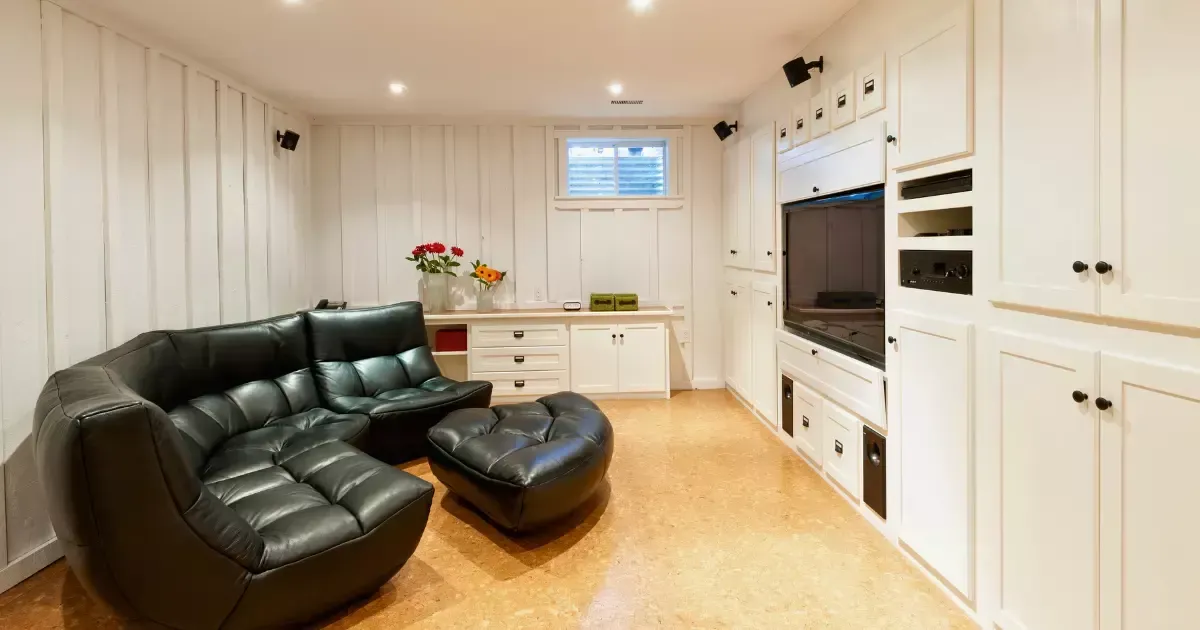
Now that your basement is finally complete, it’s crucial to maintain it properly to ensure that it remains a beautiful and functional space for years to come. In this section, we’ll discuss some tips and tricks for keeping your finished basement clean and well-maintained, preventing water damage, repairing any damages that may occur, and upgrading and updating your space over time.
Regular Cleaning and Maintenance
Regular cleaning and maintenance are crucial for keeping your finished basement in top condition. This includes vacuuming or sweeping the floors, wiping down surfaces, dusting the basement ceiling and switch plates, and cleaning windows or doors. Depending on the materials you used to finish your basement, you may also need to do some additional maintenance, such as resealing or refinishing any wood surfaces, repairing any cracks or damage to your floor models, and checking your plumbing installation for leaks or other issues.
Prevent Water Damage
One of the most significant risks to a finished basement is water damage. To prevent water damage from occurring, there are a few things you can do.
First, ensure that any new walls or partition walls installed during the finishing process are adequately sealed and insulated. This will help prevent moisture from seeping in and causing damage.
Additionally, consider installing a sump pump or backup battery to help prevent flooding during heavy rainstorms.
Finally, regularly inspect your basement for signs of water damage, such as dampness, mold, or musty odors.
Repair Damages
Even with proper maintenance and preventative measures, damages can still occur in your finished basement. If you notice any cracks or other damage to your walls or ceiling, it’s essential to address them immediately to prevent further damage. Depending on the severity of the damage, you may need to hire a professional to repair or replace the damaged areas. This can include repairing or replacing floor models, walls, ceiling tiles, or switch plates.
Upgrade and Update
Over time, you can update or upgrade your finished basement to keep it looking fresh and modern. This can include replacing old carpeting or flooring with new, more durable options, updating your plumbing installation, adding new walls or partition walls to create more defined spaces, or updating your lighting fixtures or switch plates. Depending on your budget and the scope of the upgrades, you can hire a professional contractor to help with the project.
Wrapping Up
In this ultimate guide to basement finishing, we’ve covered everything you need to know to turn your unfinished basement into a functional and comfortable living space. We discussed the benefits of finishing your basement, the critical considerations for planning and design, and the various materials and finishes you can use to create the perfect space for your needs. We shared practical tips for maximizing functionality and maintaining your finished basement.
We also explored basement finishing costs, including the average cost per square foot and the factors affecting the final price. By understanding these costs, you can better plan and budget for your basement renovation project.
Finishing your basement can be a great way to add valuable living space to your home and increase its resale value. With careful planning and the right contractor, you can transform your basement into a beautiful and functional space that your family will enjoy for years.
If you’re looking for a reliable and locally owned contractor for your basement finishing project in Northern Colorado, look no further than Local MAP Construction. Our basement finishing starts at $60 per square foot. Our experienced professionals can guide you through every step of the process, from design and planning to construction and finishing touches.
We offer a range of services to meet your needs and budget, including a free estimate and the ability to book an appointment to discuss your project in detail. With our commitment to quality and customer satisfaction, you can trust that your basement finishing project is in good hands with Local MAP Construction.
Contact Local MAP Construction today if you’re ready to start your basement finishing project. You can visit our website to book an appointment and get a free estimate or call us directly to speak with one of our friendly team members. Don’t wait any longer to create the perfect living space for your family – start today with Local MAP Construction.
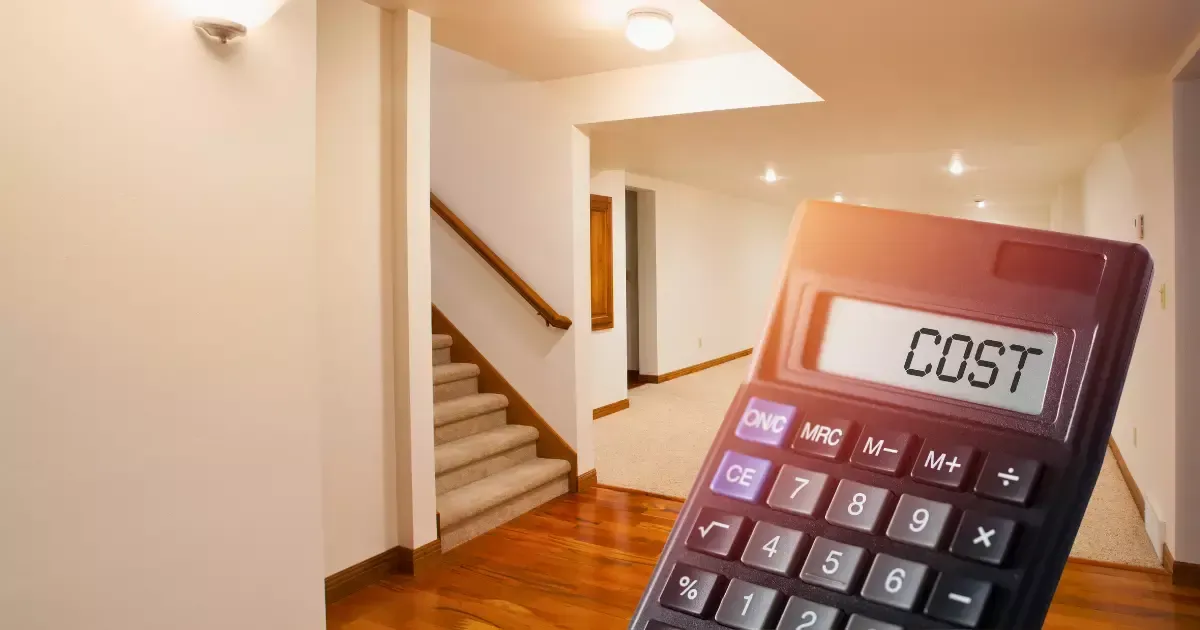
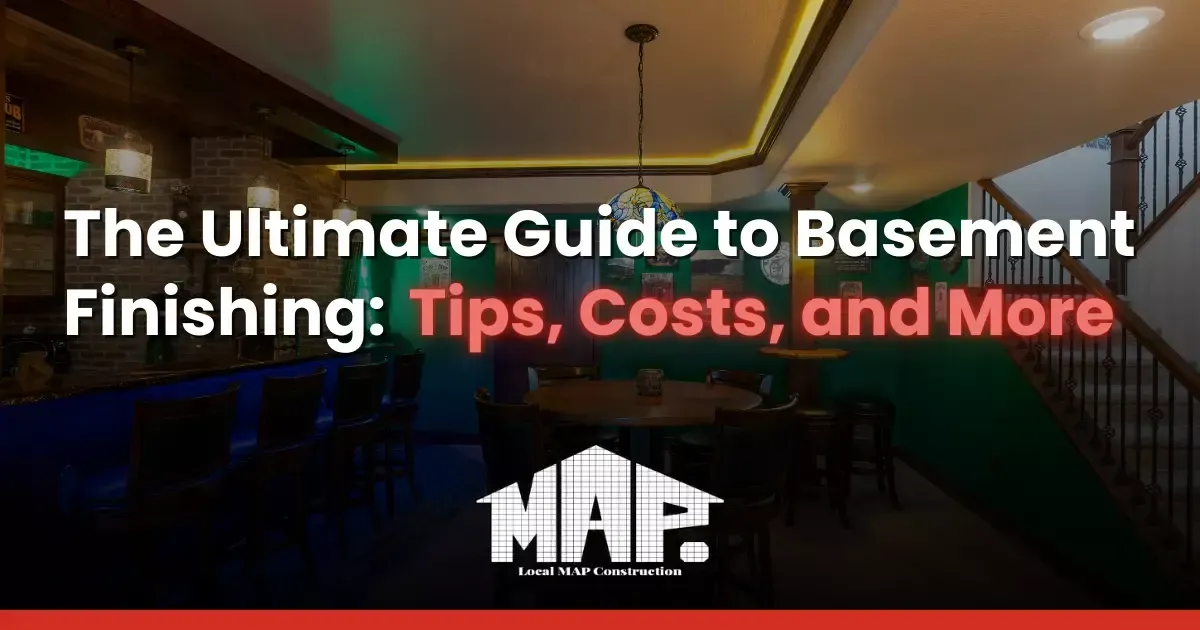
Local MAP Construction
strives to be in constant communication with our customers until the job is done. For estimates or questions on our services… please contact us at your convenience. We look forward to working with you!
- 720-635-2941
- lomapco1@gmail.com
- 443 E 4th St Suite 108, Loveland, CO 80537, United States
Company Information
Services
Locations
Copyright | 2022 Local MAP Construction LLC | Powered by Tipping Point Digital Contractor Marketing Agency
